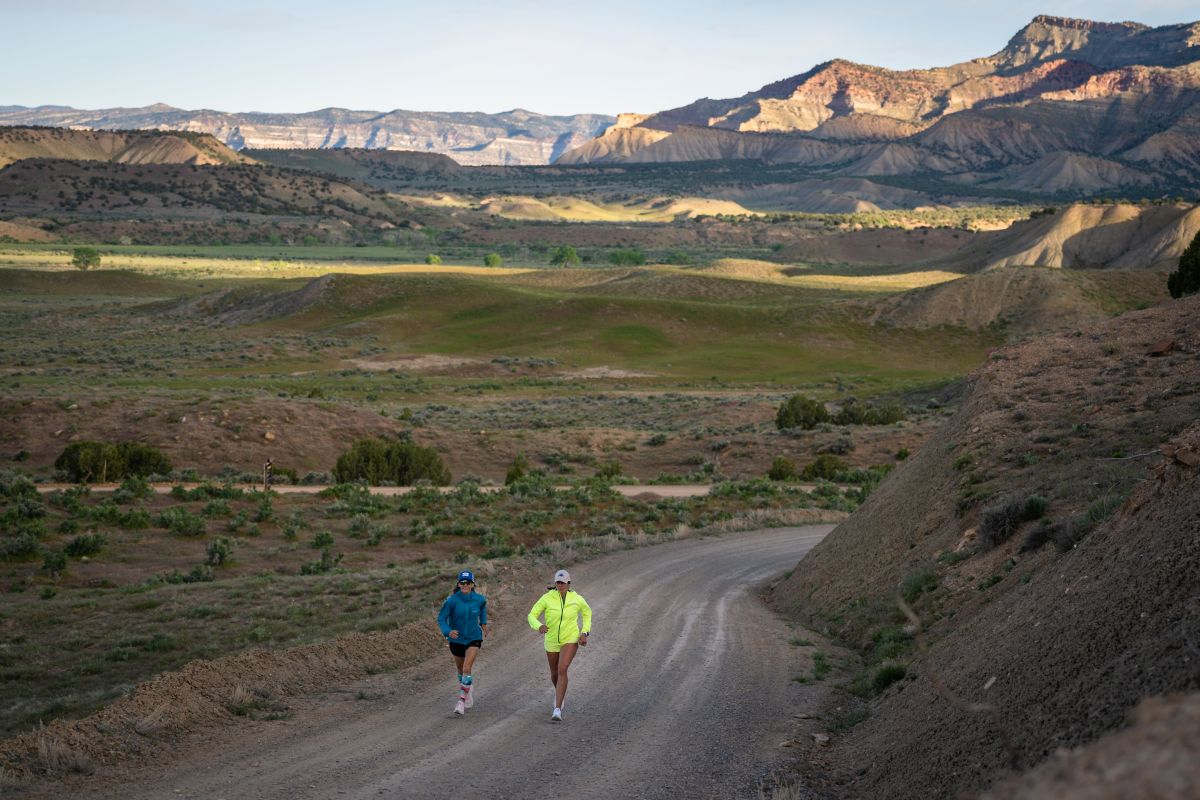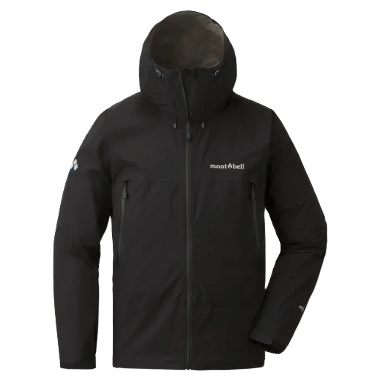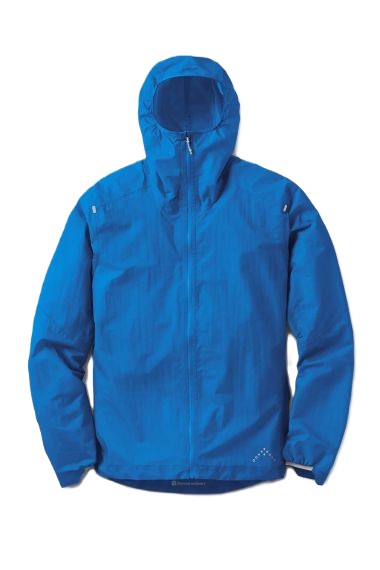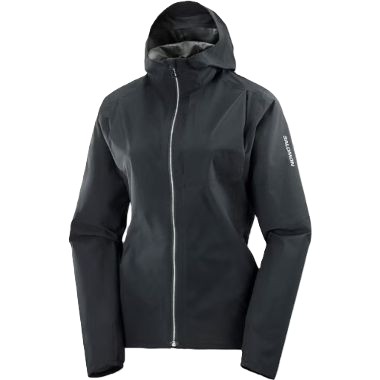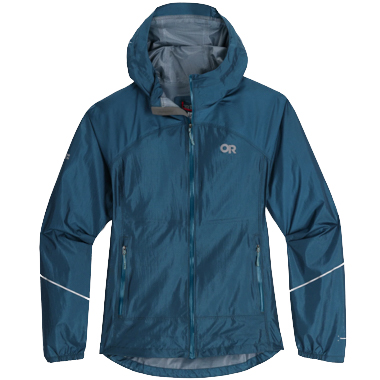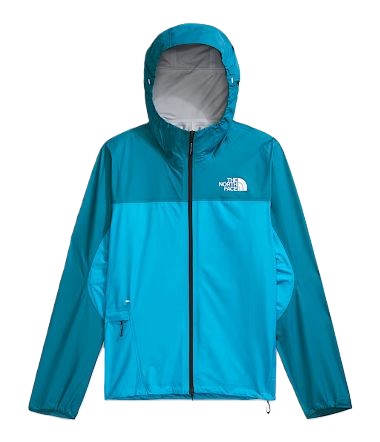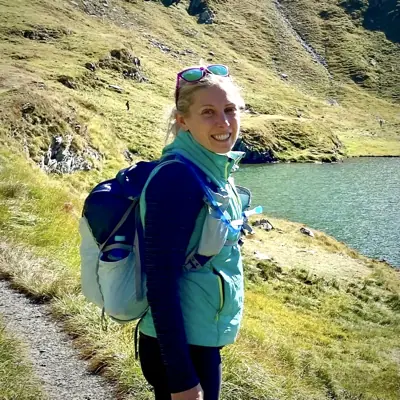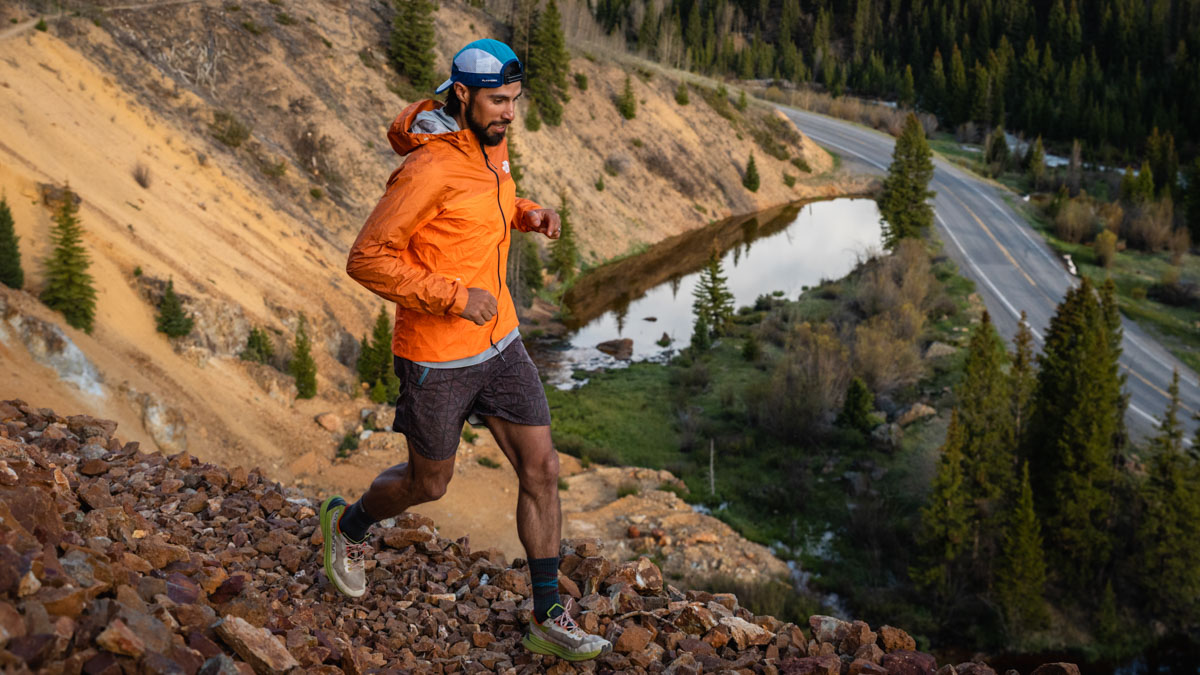
The best running rain jacket will hit the right combination of waterproofness and breathability. Photo: iRunFar/Eszter Horanyi
We runners aren’t known for our fair-weather tendencies, so many of us are constantly searching for the best running rain jacket to help us get outside and stay running in stormy weather. While splashing through some puddles or weathering a drizzle on a short run may not be a big deal, running in wet weather for a long time can be anything from simply uncomfortable to downright dangerous in colder temperatures. A solid rain jacket is a must-have for runners looking to train at a high level, no matter the weather.
There are several factors to consider when choosing the best running rain jacket — weight, packability, and, of course, waterproofness are some of the most important — and we’re here to help you parse through the top options. After researching the seemingly endless supply of rain jackets on the market, we took the most promising ones out for testing to select the best rain jackets for running. The team at iRunFar consists of professional and recreational ultrarunners and trail runners, and we tested rain jackets in some seriously wet — and snowy — conditions, including desert downpours, drizzle in the Pacific Northwest, summertime storms in Colorado’s San Juan Mountains, atmospheric river events in California, and the notoriously wet and wild weather of New Zealand.
After this extensive testing, we chose the Patagonia Storm Racer Jacket as our top rain jacket for its combination of performance, low weight, and fit, and the gram-counters on our team turned to the Rab Phantom Waterproof Jacket when they wanted an ultralight option to minimize pack weight. From the Aero Pack System on the Salomon Bonatti Trail to the near-perfect hood of the Outdoor Research Helium Rain Ultralight Jacket, we have you covered on all the unique features of the best running rain jackets.
After you read our product reviews, check out our buying advice, testing methodology, and frequently asked questions below for more information. And if you’re looking for a windbreaker jacket instead, check out our Best Windbreaker Jackets guide.
The Best Running Rain Jackets
- Best Overall Running Rain Jacket: Patagonia Storm Racer Jacket
- Best Overall Running Rain Jacket Runner-Up: Montbell Rain Trekker Jacket
- Best Ultralight Running Rain Jacket: Rab Phantom Waterproof Jacket
- Other Great Running Rain Jackets: Salomon Bonatti Trail, Outdoor Research Helium Rain Ultralight Jacket, The North Face Summit Series Superior Futurelight Jacket
Best Overall Running Rain Jacket: Patagonia Storm Racer Jacket ($300)
- Excellent waterproofing and fit
- Lightweight and comfortable
Cons:
- It’s tough to fit in the built-in stuff pocket
The Patagonia Storm Racer Jacket is a lightweight, durable, and breathable jacket that kept us dry in the worst weather conditions. It finds the right balance between all the components that make a good rain jacket. While the previous version of this jacket had a pullover style with a side zip, the new version has returned to a full front zipper, and we’re happy about the change. This jacket is fairly minimalist and doesn’t have hand pockets, but it does have a zippered chest pocket for storing small items.
The jacket’s relatively slim and athletic cut is loose enough to fit over layers but tight enough that it doesn’t flop around in the wind. The three-layer construction makes this one of the most effective rain jackets on the market, and it kept us dry on runs during atmospheric river events in California. We also took it to higher elevations, and it held up well in some wet snowfall in the San Bernardino Mountains. While we’d love for any rain jacket to be more breathable so that we don’t have to worry about sweating underneath it during warmer but wet conditions, this one does a reasonable job of releasing moisture from the inside.
We always appreciate Patagonia’s commitment to protecting the environment and being a leader in planet-friendly gear manufacturing. This jacket is made of 100% recycled nylon ripstop fabric with a durable water-repellent (DWR) coating free of perfluorinated chemicals (PFCs/PFAS). It’s also made in a Fair Trade Certified factory.
We also included this jacket in our Best Running Jackets guide for many reasons, but the most important is that it simply kept us dry and warm when we needed it to.
Claimed Weight (men’s): 204 grams (7.2 ounces) | Material: 100% recycled nylon ripstop face | Construction: Three-layer construction
Shop the Men's Patagonia Storm Racer JacketShop the Women's Patagonia Storm Racer Jacket
Best Running Rain Jacket — Runner-Up: Montbell Rain Trekker Jacket ($220)
Pros:
- Quiet fabric
- Waterproof yet reasonably breathable
- Fewer seams for potential moisture entry
Cons:
- Separate stuff sack is easy to misplace
- Not as breathable as some other jackets
The Montbell Rain Trekker Jacket is a feature-filled jacket that earned high marks from our testers for its waterproofness and breathability. Montbell built this jacket using a single piece of fabric. This unique K-Mono Cut design reduces both the weight of the jacket and the number of seams for improved protection from the elements. Montbell bases many of its designs on the Japanese concept of “Ki-no-bi,” which roughly translates to “Function is Beauty,” something the company takes to heart with its designs. The fully sealed seams prevent moisture from seeping in.
The Gore-Tex Windstopper membrane is paired with a 20-denier nylon outer with a durable water-repellent (DWR) coating to create a lightweight yet protective two-layer jacket that our testers found functions well on both rainy days and in winter snowstorms. Multiple adjustment points on the hood, cuffs, and hem allow for a customizable fit to optimize comfort and better protect from wet weather.
This jacket also includes a water-resistant zipper, hook-and-loop closures to secure the hood when it’s not in use, and a cut that allows for full arm range of motion without pulling on the jacket body. We found this fabric to be quiet while moving, a bonus for those who get annoyed by the incessant crinkling and swishing sounds that many rain jackets make.
The sizing was adequate for layering and wearing a small pack underneath, but you will likely need to size up if you want to wear bulkier layers or a larger loaded pack. Two waterproof external pockets on the chest can accommodate small items for easy access. The jacket also has a separate stuff sack for storing it on the go.
Actual Weight (men’s medium): 195 grams (6.9 ounces) | Material: Gore-Tex Windstopper | Construction: Two-layer construction
Shop the Men's Montbell Rain Trekker JacketShop the Women's Montbell Rain Trekker Jacket
Best Ultralight Running Rain Jacket: Rab Phantom Waterproof Jacket ($200)
- Lightweight and packable
- Material has some stretch for comfort and ease of movement
- Stuff sack included for packing
Cons:
- Slim fit does not accommodate many layers or a pack underneath
- Material is noisy when moving
We named the Rab Phantom Waterproof Jacket our top ultralight jacket because of its impressively low weight and breathability. The jacket features a 2.5-layer construction with a Pertex Shield waterproof membrane and fully taped seams for maximum protection. To save weight, this ultralight jacket skips bungees on the roll-away hood, cuffs, and hem, which makes it less adjustable than some of the other options in this guide. It also doesn’t have any pockets. But it’s light!
The water-resistant zipper is smooth and moves well with no catching, which is rare in the ultralight jacket world. The material has some stretch, making it comfortable on the move, but it is louder than some of the other jackets on the list, which can be distracting on the trail if you’re sensitive to extraneous noise. It has a slimmer profile and tighter fit, which is useful for keeping the jacket from shifting or flapping while on the move or in the wind, but it does make it more challenging to take on and off quickly while running, though the updated full zip mitigates some of those issues. You’ll want to size up if you’re going to wear heavier layers or a pack underneath.
You can read more about a previous version of this jacket in our in-depth Rab Trail Running Apparel review.
Claimed Weight (men’s medium): 117 grams (4.1 ounces) | Material: Pertex Shield | Construction: 2.5 layers
Shop the Men's Rab Phantom Waterproof JacketOther Great Running Jackets
Salomon Bonatti Trail ($230)
Pros:
- Breathable and waterproof with several thoughtful features
- Can be worn over a pack
- Lightweight, compact, and stylish
Cons:
- Waterproofness wanes over time
The Salomon Bonatti Trail is another top pick for running rain jackets because of its balance between its breathability, ability to provide protection from the elements, and thoughtful design. “It’s the best waterproof running jacket for wet conditions when you don’t want to overheat,” our primary tester wrote of this jacket. “It got me through a 10-hour ultra in a rain weather warning in Ireland, and I was still pretty dry at the end.”
This lightweight, compact jacket has a 2.5-layer construction with a Pertex Shield waterproof membrane, waterproof zipper, tight-fitting hood, waist drawcord to dial in the fit, and easily accessible chest pocket. It also features a snap button on the chest that allows you to wear it unzipped for extra air flow while keeping the jacket in place. Perhaps its most unique feature, though, is the extra volume in the back of the jacket — Salomon calls it the Aero Pack System — that is designed to allow it to fit over a running pack. The chest pocket also has a hole for easy access to a bottle. With or without a pack underneath, this jacket is a slim fit.
Our tester’s only qualm with this jacket is its durability. “I only seem to get a year or so out of one with regular use before it starts to get less waterproof,” she wrote.
Claimed Weight (men’s medium): 198 grams (7 ounces) | Material: Pertex Shield | Construction: 2.5 layers
Shop the Men's Salomon Bonatti TrailShop the Women's Salomon Bonatti Trail
Outdoor Research Helium Rain Ultralight Jacket ($170)
- Lightweight and easily packable
- Excellent features for the price, including a top-notch hood
Cons:
- Feels muggy in warmer temperatures
- The zipper can be fragile
- Will soak through in heavy rain
The Outdoor Research Helium Rain Ultralight Jacket is a lightweight, waterproof jacket that packs a lot of punch for its price point and weight. While it certainly isn’t inexpensive, the number of features and protection it offers make it worth the investment.
This is a 2.5-layer jacket featuring a Pertex Shield waterproof membrane coupled with a 30-denier nylon outer to provide water protection in a very lightweight package. It has fully taped seams, a water-resistant zipper, and an adjustable hem and hood. The zipper is tiny — zip it carefully so as not to damage it. After several seasons of use, we did break the zipper, but Outdoor Research offers a lifetime guarantee on its products and replaced it without fuss.
We loved the hood of this jacket and found that it easily fit a winter or brimmed hat underneath it. It also provides plenty of room for a ponytail. An adjustable bungee kept it in place when the rain and wind hit. The single zip pocket on this jacket also serves as a stuff sack for storing the jacket when not in use.
The somewhat relaxed fit allows for some layering, but it’s not so loose that it flaps around while on the move. We recommend sizing up to accommodate thicker layers or a hydration pack underneath. The jacket is less breathable than others we tested and felt a little muggy on warmer runs.
Our long-term testers found that the jacket became less waterproof with extended use and would start soaking through during longer stints in heavy rain. It’s probably not the rain jacket we would choose if we regularly ran in heavy rain. That said, it can keep you dry during afternoon storms as a piece of mandatory race gear. We also frequently carried this jacket instead of a windbreaker on runs where there was a slight chance of precipitation in the forecast. It’s not that much heavier than many windbreakers, and we appreciated having the peace of mind. Overall, it’s a jacket that works for most people most of the time at a reasonable price.
Actual Weight (men’s medium): 178 grams (6.3 ounces) | Material: Pertex Shield | Construction: 2.5 layers
Shop the Men's Outdoor Research Helium Rain Ultralight JacketShop the Women's Outdoor Research Helium Rain Ultralight Jacket
The North Face Summit Series Superior Futurelight Jacket ($300)
Pros:
- Excellent breathability
- Good protection from rain and snow
- Quiet material
Cons:
- Expensive
- Heavier than others tested
- Women’s fit ran short and did not provide adequate coverage (so get a men’s instead!)
The North Face Summit Series Superior Futurelight Jacket is a great option that our testers hailed for its performance on long, bad-weather days and their top choice for snowy winter runs. This three-layer jacket’s combination of The North Face’s Futurelight 3L material, fully taped seams, and an external durable water repellent (DWR)-treated nylon layer kept rain and snow out. The jacket was one of our top performers in breathability as well. An adjustable hood and hem help to dial the fit in and keep the weather out. We also found this material to be quiet when we were running. One rear inner mesh pocket provides a small amount of storage and serves as a stuff sack when storing the jacket in a pack. One tradeoff for this jacket’s all-day level of protection is its weight, as it is one of the heaviest we tested. It’s also the most expensive jacket in this guide. Still, we also named it our top rain jacket in our Best Cold Weather Running Gear guide.
Our testers found that the women’s version ran very short with a cut and crop that was not adequate for protection during bad-weather running, so our women testers ended up testing the men’s jacket as well. The previous version of the women’s jacket was appropriately cut for full rain coverage, and our women testers were jealous of the appropriate cut of the men’s version. We hope in the future The North Face brings back the women’s version in a cut that makes this jacket functional and safe for foul-weather running.
For a more in-depth look, you can read our review of a previous version of The North Face Summit Series Superior Futurelight Jacket.
Actual Weight (men’s medium): 236 grams (8.3 ounces) | Material: The North Face Futurelight | Construction: 3 layers
Shop the Men's The North Face Summit Series Superior Futurelight JacketShop the Women's The North Face Summit Series Superior Futurelight Jacket
Comparing the Best Rain Jackets for Running
| RAIN JACKET | PRICE | WEIGHT | MATERIAL/CONSTRUCTION |
| Patagonia Storm Racer Jacket | $300 | 7.2 ounces | Three-layer, recycled nylon ripstop |
| Montbell Rain Trekker Jacket | $220 | 6.9 ounces | Two-layer, Gore-Tex Windstopper |
| Rab Phantom Waterproof Jacket | $200 | 4.1 ounces | 2.5-layer, Pertex Shield |
| Salomon Bonatti Trail | $230 | 6.9 ounces | 2.5-layer, Pertex Shield |
| Outdoor Research Helium Rain Ultralight Jacket | $170 | 6.3 ounces | 2.5-layer, Pertex Shield |
| The North Face Summit Series Superior Futurelight Jacket | $300 | 8.3 ounces | Three-layer, The North Face Futurelight |
Running Rain Jackets Glossary
The technology that goes into high-quality waterproof outdoor gear, like a running rain jacket, is impressive — and can get confusing! Below, we’ve compiled some definitions for common waterproof gear terms to clarify their meanings.
- Durable Water Repellent (DWR) Coating: DWR is a hydrophobic — a fancy word for water-repellent — coating applied to fabric that causes water to bead up on the surface and roll off, keeping it from soaking into the material. DWR coatings are historically fluoropolymer-based, and their manufacturing produces several environmentally harmful by-products. Because of this, many companies are working toward using non-perfluorinated chemicals (non-PFC) in their DWR coatings.
- Moisture Vapor Transmission Rate (MVTR): MVTR is a laboratory testing method to measure a material’s breathability by measuring the amount of moisture vapor (evaporating sweat) that can pass through the fabric. It is measured in grams of vapor per square meter of fabric per 24 hours. The higher the number, the more breathable the material. A moderate breathability rating starts at around 10,000 g/m2.
- Resistance to Evaporative Heat Loss (RET): RET is another measure of a material’s breathability that measures its resistance to water vapor. The lower the resistance, the more vapor can pass through — thus, the lower the RET, the more breathable the material. A rating of less than 13 is considered good breathability for running.
- Hydrostatic Head Test: A laboratory test to quantify the waterproofness of a material. Material is stretched over the end of a one-inch diameter tube, and a column of water whose height is measured in millimeters is added to the tube and observed for 24 hours. The rating measures how many millimeters of water a fabric can hold before it soaks through. The water height at which the water seeps through the fabric is called the hydrostatic head, and the final rating is given in millimeters of water. The higher the number, the more waterproof the material, with the lower end of waterproof jackets starting at around 10,000 millimeters.
- Schmerber Unit: This is another name for the hydrostatic head waterproofness measure. It’s named for Charles Edouard Schmerber, who created the test.
- Waterproof Membrane: A waterproof membrane is a synthetic material that blocks and repels water. It is usually bonded or layered with an outer material layer or inner liner to create a waterproof jacket. Some brands that make these membranes include Gore-Tex, eVent, Polartec Neoshell, and Pertex.
- Denier: Measurement of the thickness of a material’s fiber. A higher denier denotes a thicker and often heavier and more durable fiber.
- Wetting Out: The point at which water overwhelms the waterproof capability of a jacket material.
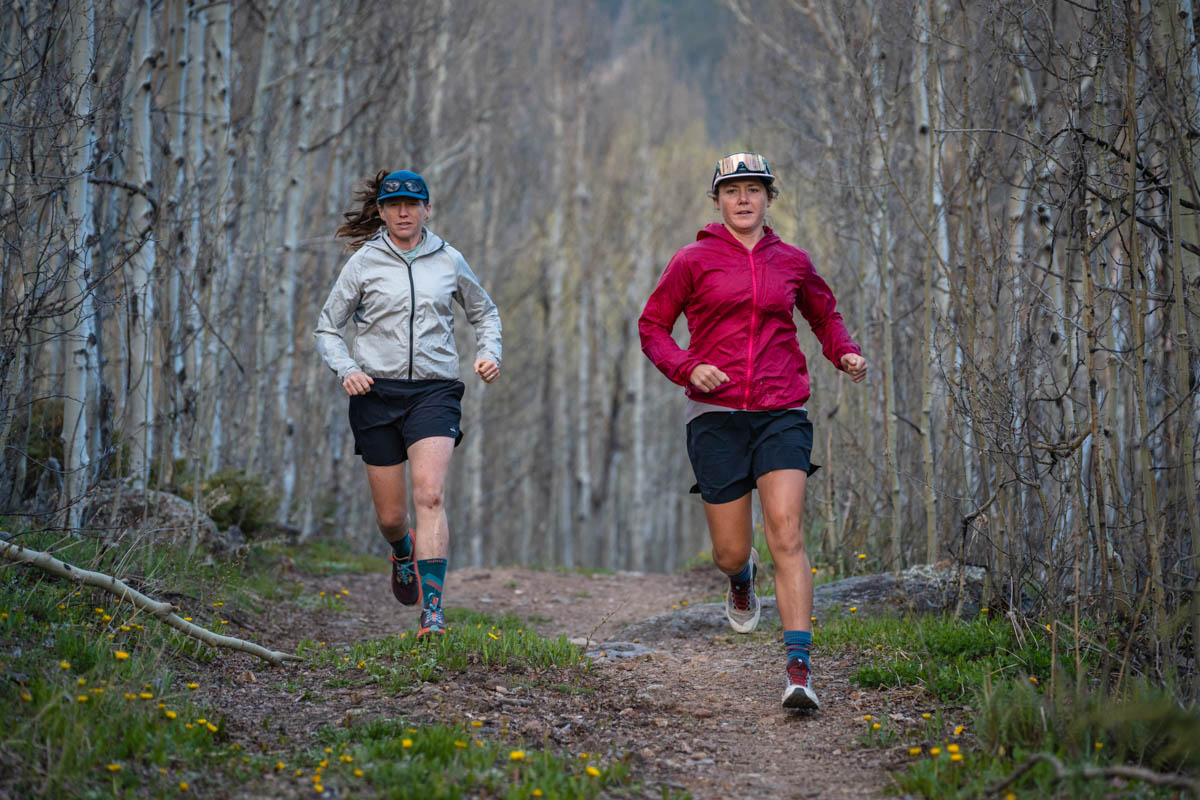
There are a seemingly endless number of running rain jacket options on the market, and we tested dozens in a variety of conditions. Photo: iRunFar/Eszter Horanyi
Buyer’s Guide: How to Choose a Running Rain Jacket
Fit
Just like any other piece of clothing, fit is the most important aspect of a jacket, and preferences vary from person to person. Do you want something that fits a bit tighter or a jacket that you can wear with layers underneath? The fit and coverage of rain jackets should prevent moisture from getting in, even if you are bending over or moving your head around underneath the hood.
Another consideration when choosing your jacket is its ability to accommodate a pack. Some runners prefer to wear a jacket under their pack, while others would rather wear it over their pack to keep gear dry and make it quicker and easier to take the jacket on and off. Some jackets, like the Salomon Bonatti Trail, are designed to fit a pack underneath, but most others will require sizing up to do this.
The best running rain jacket will cover your wrists well, and the hem will stay below your waistline when you raise your arms. Some jackets, like the Montbell Rain Trekker Jacket, have elastic cords that allow for some cinching of the hem, cuffs, and hood to keep them securely in place and help provide a more custom fit. A jacket should also have enough room in the shoulders or adequate stretch in the material to allow for a full range of arm motion when running, including reaching for things in your pack, scrambling on technical terrain, or just bending over to tie your shoe.
An important thing to remember when considering fit for a rain jacket is that some waterproof options, like the Outdoor Research Helium Rain Ultralight Jacket, don’t have much stretch or give to the materials, so this is an item of clothing you may want to size up on to allow for freedom of movement and layering.
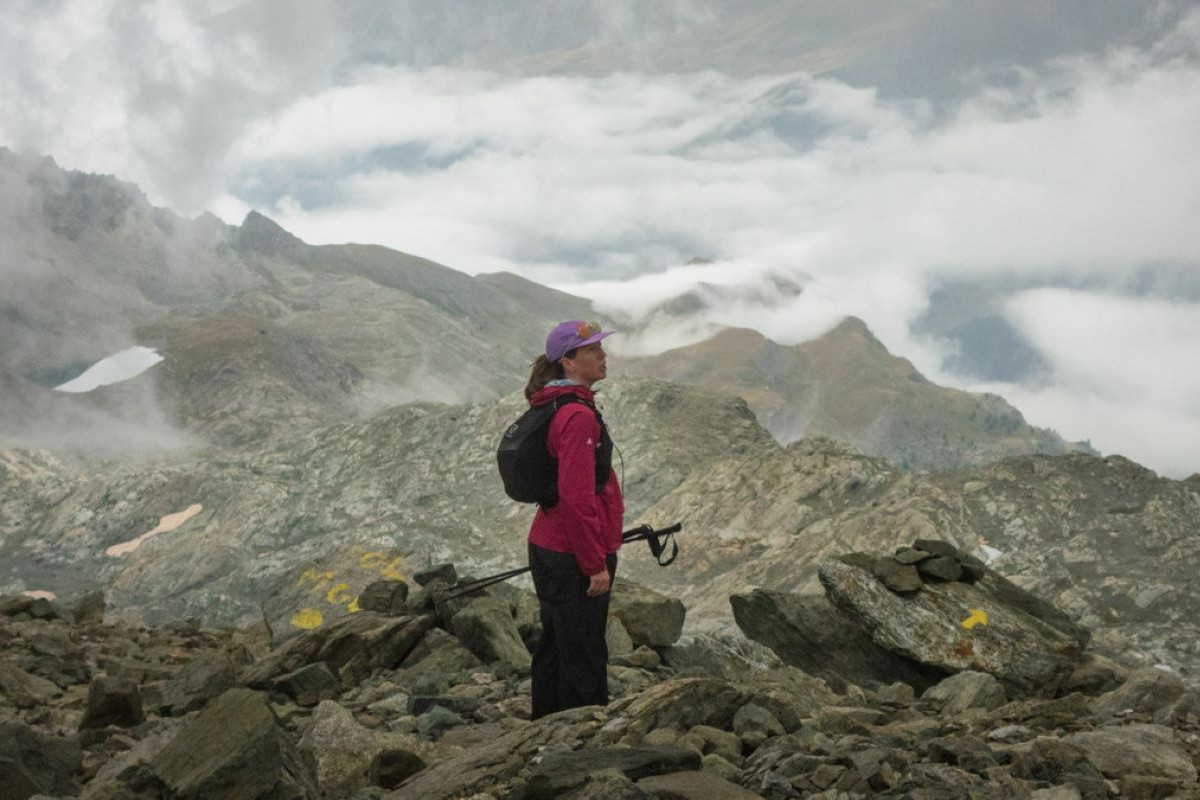
iRunFar Editor-in-Chief Meghan Hicks tests out the Montbell Rain Trekker Jacket in the Italian Alps. Photo: iRunFar/Eszter Horanyi
Waterproof Versus Water-Resistant
The waterproof protection offered by running jackets varies from repelling a few sprinkles to keeping out a monsoon. A water-resistant jacket will protect from a brief shower with the help of a durable water-repellent (DWR) coating. While water-resistant jackets are lightweight and packable, they will not keep you dry in extended wet weather, as the underlying materials are not waterproof themselves, and persistent rain will overwhelm the DWR coating. You can check out our Best Running Jackets guide for some great examples of lightweight, water-resistant running jackets. If you’re just looking for a jacket to keep the wind off, check out our Best Windbreaker Jackets guide.
The outer layer of most waterproof jackets repels water from its surface using a DWR coating, and the bottom layers protect against higher moisture levels. The best running rain jackets will keep you dry during prolonged wet conditions, such as long, soaking rain or wet snowfall. A fully waterproof jacket will provide true protection from the elements. All of the features of the Patagonia Storm Racer Jacket, including its waterproof qualities, led us to name it the best running rain jacket. It’s important that the waterproof layer in a rain jacket is breathable so that moisture from your skin can evaporate and move through it and not leave you soaked from the inside.
PFC/PFAS Chemicals
Perfluoroalkyl and polyfluoroalkyl (PFAS) chemicals, also known as perfluorinated compounds (PFCs), are highly toxic fluorinated materials that made headlines when the Environmental Protection Agency announced that local water systems must monitor PFAS levels and remove them from tap water.
Manufacturers have utilized PFAS chemicals in many products, including waterproof fabrics, for decades. Nowadays, many brands — like Patagonia with its Patagonia Storm Racer Jacket and The North Face with its The North Face Summit Series Superior Futurelight Jacket — are creating proprietary waterproof fabrics and treatments without PFAS chemicals. The Rab Phantom Waterproof Jacket is also PFAS-free.
The best way to ensure you’re purchasing a PFAS-free piece of clothing or gear is to read the manufacturing details. Most running and outdoor brands tout their PFAS/PFC-free materials and water-repellent treatments, so it should be fairly easy to identify.
Breathability
The primary purpose of a rain jacket is to keep you dry. The tradeoff for this, however, is often breathability. Most people have put on a rain jacket in a light sprinkle and gotten more wet from sweat than they would have if they had not worn a jacket at all. The best running rain jackets have come a long way from plastic bag-like ponchos, and many offer both excellent moisture protection and breathability.
The conditions in which you will be using your jacket can inform the balance of these two features you choose. For brief showers in warm climates, you can sacrifice a little waterproofness for more breathability, whereas you may want to prioritize waterproofness in an all-day soaker or when temperatures are hovering just above freezing.
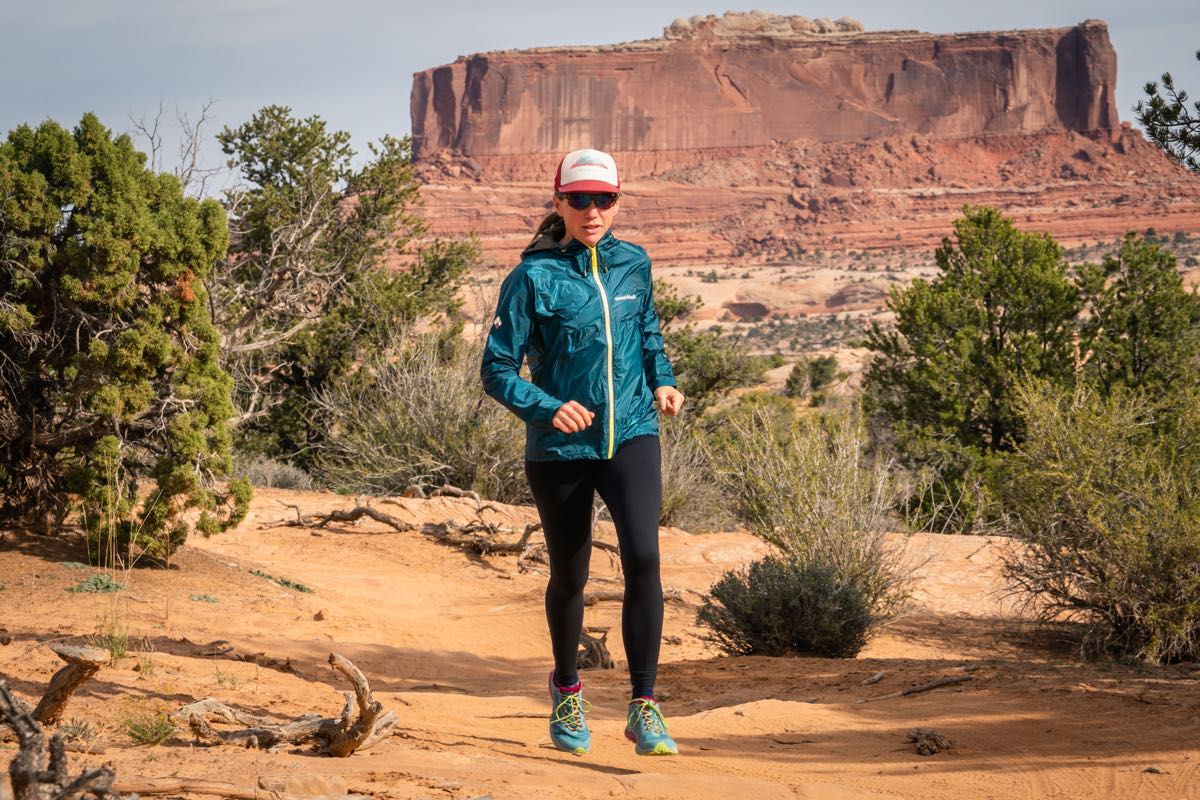
Meghan Hicks tests a lightweight rain jacket on a cool desert morning. Photo: iRunFar/Eszter Horanyi
Waterproof jackets are made of fabrics that have permeable membranes with microscopic holes big enough to let water vapor from your body escape but small enough to block water droplets from the outside. This allows them to be both waterproof and breathable. This technology comes at a premium price, though.
Generally, the lighter and more breathable a waterproof jacket is, the higher the price tag. A pricey jacket with all the bells and whistles may not make sense for everyone, but if you are spending hours running in a cold and soaking rain, the combination of good breathability and waterproof capability can quite literally be a lifesaver.
Some laboratory values quantify a jacket’s breathability, including its MVRT or RET (see our glossary of terms above). These measures give a reference point for the objective breathability of a material, but as with many types of technology analyzed in a lab, real-world performance doesn’t always agree. Real-world breathability can depend on several external factors, like temperature, humidity, or a person’s sweat rate.
Protection
Staying dry when wet weather rolls in is why you are looking for the best running rain jacket in the first place. As we mentioned above, how a rain jacket provides waterproof protection will vary from brand to brand, but generally, it is a waterproof membrane — such as Gore-Tex, eVent, or Pertex — that layers with other fabrics.
A rain jacket is generally made of either two, 2.5, or three layers. In a two-layer jacket, such as the Montbell Rain Trekker Jacket, an outer layer of DWR-coated nylon is layered or bonded to a waterproof membrane, such as Gore-Tex or similar.
A 2.5-layer jacket, such as our favorite ultralight jacket, the Rab Phantom Waterproof Jacket, adds a coating on the innermost layer to protect it from body oils, sweat, and other substances that can degrade the material. This coating is considered half a layer because it’s not an entirely separate layer of material.
A three-layer jacket, like the Patagonia Storm Racer Jacket, features the outer layer bonded to the waterproof membrane, with an additional full inner layer of material. A three-layer jacket will, in theory, give you the most protection from the elements but at an increased weight and with reduced breathability.
When choosing a running jacket, more is not always more when it comes to layers. Most of our top choices for this guide are two- or 2.5-layer jackets, and that’s because we have found them to have the balance of waterproofness and breathability that runners want.
In addition to the jacket’s materials and layer structure, additional features such as taped seams and water-resistant zippers add extra protection to keep you dry.

Rain jackets can come with a variety of features, including multiple pockets and hood and hem adjustment options. Photo: iRunFar/Eszter Horanyi
Features
Several features enhance the fit and function of a quality waterproof jacket. While companies may tout a whole host of bells and whistles to set their jackets apart from the rest, we think a few key features are the most important to consider when shopping for the best running rain jacket.
- Hood: First, a well-fitting hood is necessary for keeping rain and snow out. At the very least, the hood should include some elastic edging, like the Rab Phantom Waterproof Jacket does, to allow it to stretch around your head and face and stay in place while moving. A more full-featured jacket, such as the Montbell Rain Trekker Jacket, will have additional adjustment points, usually in the form of elastic draw cords, on the front and back of a hood to help cinch it in place, adjust the brim, and allow it to follow your head movements. A built-in brim on a hood, like the one on the Outdoor Research Helium Rain Ultralight Jacket, will help to shed water and protect your face from the rain.
- Taped Seams: Seams are an unavoidable weakness in any jacket’s waterproofness that can allow moisture to get in. Fully waterproof jackets remedy this problem with a layer of material, usually thermoplastic tape, that is bonded and heat-sealed over the seams on the jacket’s interior. The Montbell Rain Trekker Jacket is made of a single piece of material to minimize the number of seams on the jacket.
- Zipper: The zipper is another potential moisture entry point on a jacket. All the jackets featured in this buyer’s guide use water-resistant zippers that help seal out the elements. The technology in these zippers can cause some to move slower than a traditional fabric zipper, and some of the smaller zippers are delicate.
- Adjustment Points: In addition to the elastic adjustments on the hood, many jackets will also include an elastic cord on the hem or waist to allow the wearer to cinch the bottom of the jacket and dial in a secure fit. Cuffs are another adjustment point, with some jackets including an elastic cinch, thumb loop, or Velcro strap to tighten or secure the cuffs to keep the sleeves from slipping or riding up with arm motion.
- Pockets: Several of our top picks have at least one pocket that can stash smaller items for easy access on the move. Using the jacket for extended periods versus as a just-in-case packable layer for short rains will help guide your desire for an outer pocket. Bear in mind that pockets add zippers, create more seams, and add extra weight, and the lightest jackets, like the Rab Phantom Waterproof Jacket, skip them altogether. You’ll want to forego pockets if you are looking for a lightweight jacket. Included pockets often serve as a built-in stuff sack for packing the jacket away.

A rain jacket like the Montbell Rain Trekker Jacket can also provide wind protection on cold peaks. Photo: iRunFar/Eszter Horanyi
Weight
As material technology advances, so does the ability to have ultralight clothing that is still functional. Still, the more durable the material and the more bells and whistles included, like pockets, zippers, and hoods, the heavier the jacket will be.
Our heaviest pick was the The North Face Summit Series Superior Futurelight Jacket, which weighs 235 grams. For a real-world reference, that’s about the weight of a cup of sugar. The ultralight Rab Phantom Waterproof Jacket came in at around half that at 116 grams, but that lightweight package means you are giving up some convenience factors like adjustable bungees on the hood and hem.
Storage
We trail runners have a tendency to carry more than our road-running counterparts. We often have keys, snacks, or a headlamp to stash away, and we like our pockets! But as we’ve said, there’s a tradeoff — more storage options result in a heavier jacket. If you’re on an adventure where you want a jacket with many pockets, you’re likely wearing something else with pockets, too, like a running vest, running shorts, or running belt. The Salomon Bonatti Trail was even designed to fit a hydration pack underneath.
Your rain jacket may be the one item for which sacrificing storage and pockets is a wise choice. Storing items in a jacket will considerably increase bouncing and can create some issues with the fit, potentially creating gaps for water seepage.
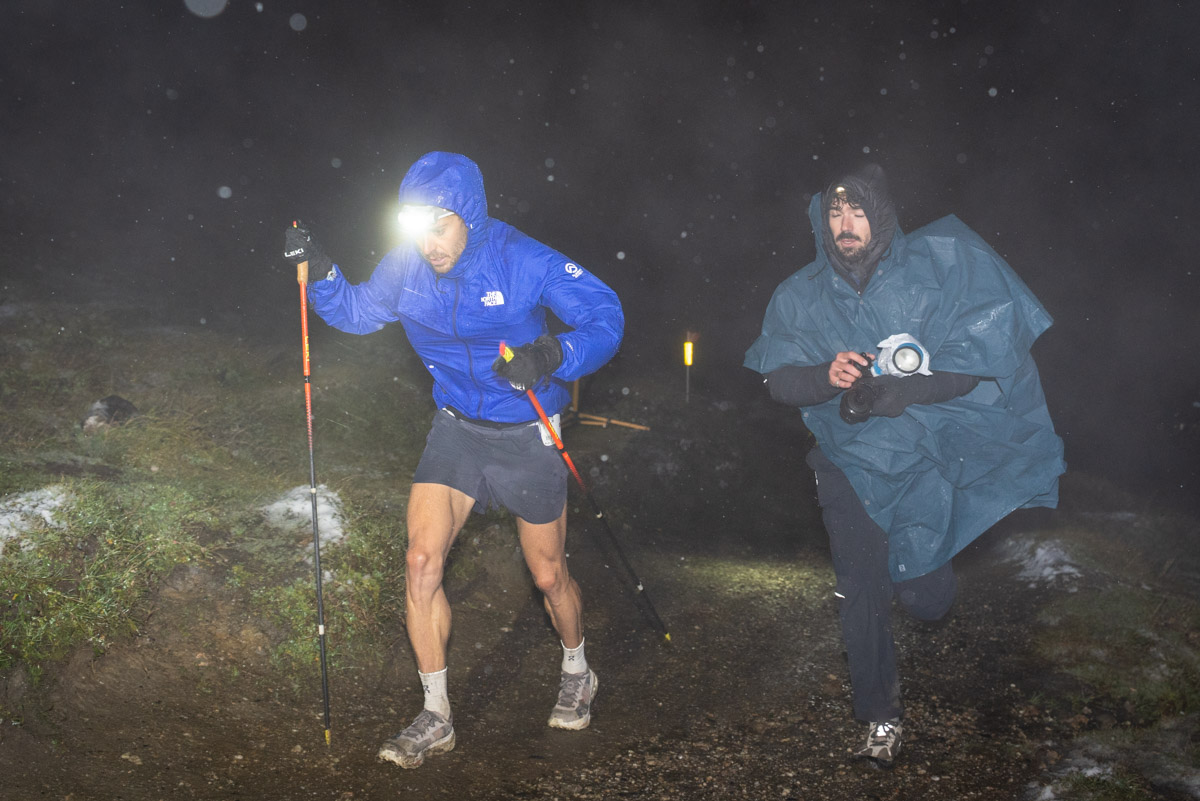
Germain Granger and a photogapher take different approaches to rain gear during the overnight rain at the 2025 UTMB. Photo: iRunFar/Eszter Horanyi
Packability
Often, a rain jacket is more of a just-in-case layer during a long event or worn during a rain shower and taken off once things dry out. Several events also require runners to carry a rain jacket during long races where they’ll be exposed to the elements. Your rain jacket will frequently just be taking a ride in your pack or waistbelt during a run, so it needs to be — you guessed it — packable.
Packability goes hand in hand with weight — usually, the lighter the jacket, the smaller it will pack down. Many of our top jacket picks have an internal pocket that the body of the jacket can roll into, producing a package no bigger than your fist that you can easily stuff into a hydration pack. Others are a bit bulkier but provide increased insulation, waterproofing, and storage capacity. Those looking to shave as much weight and volume possible with a jacket will gravitate toward a lighter jacket, like the eminently packable Outdoor Research Helium Rain Ultralight Jacket, but if you know the conditions will be wet, you might want to take the weight penalty and take a more robust jacket like the Patagonia Storm Racer Jacket or the The North Face Summit Series Superior Futurelight Jacket.

The Outdoor Research Helium Rain Ultralight Jacket can protect you from the rain and provide warmth on chilly mornings — including those in cold and wet Utah slot canyons. Photo: iRunFar/Eszter Horanyi
Layering
You’re likely to layer your jacket over a shirt, possibly an insulating layer, a hydration pack, or another jacket. In many situations, it often makes sense to size up your outermost layer to give you room to fit everything underneath. A little more breathing room also means you might be able to put your jacket on right over your pack, keeping your other gear dry, and making donning and doffing your outer layer quicker and easier. The Salomon Bonatti Trail was designed with this in mind and has extra space in the back to accommodate a pack without being bulky anywhere else. For a slimmer-fitting jacket, it’s probably smart to size up.
Why You Should Trust Us
Many members of the iRunFar team are based in the mountains, like the San Juans of Colorado, or play in the high peaks of the U.S. Pacific Northwest, which has famously unpredictable — and wet — weather. We’re used to sunny days turning to rain or a soft snowfall suddenly turning to a screaming sleet storm. We also stand around in all sorts of horrid weather during race coverage in the mountains. We understand the importance of having a waterproof rain jacket that we can trust to perform when it matters most, and we’re committed to testing products in a variety of conditions so that you don’t have to suffer the same trial and error to find the best running rain jacket.
We started our testing process with market research: Who is making the best product? We then polled our readers and iRunFar team members and chose more than 20 rain jackets to test. What you see in this guide is the result of several years of testing for all those jackets, and new ones as they come on the market. We ran in these jackets through winter snowstorms, cold dousers in the U.S. Pacific Northwest and high-altitude mountain west, humid rainstorms, desert soakers where wet sand coats all surfaces, atmospheric river events in California, and everything in between — all to find the best running rain jacket for you.
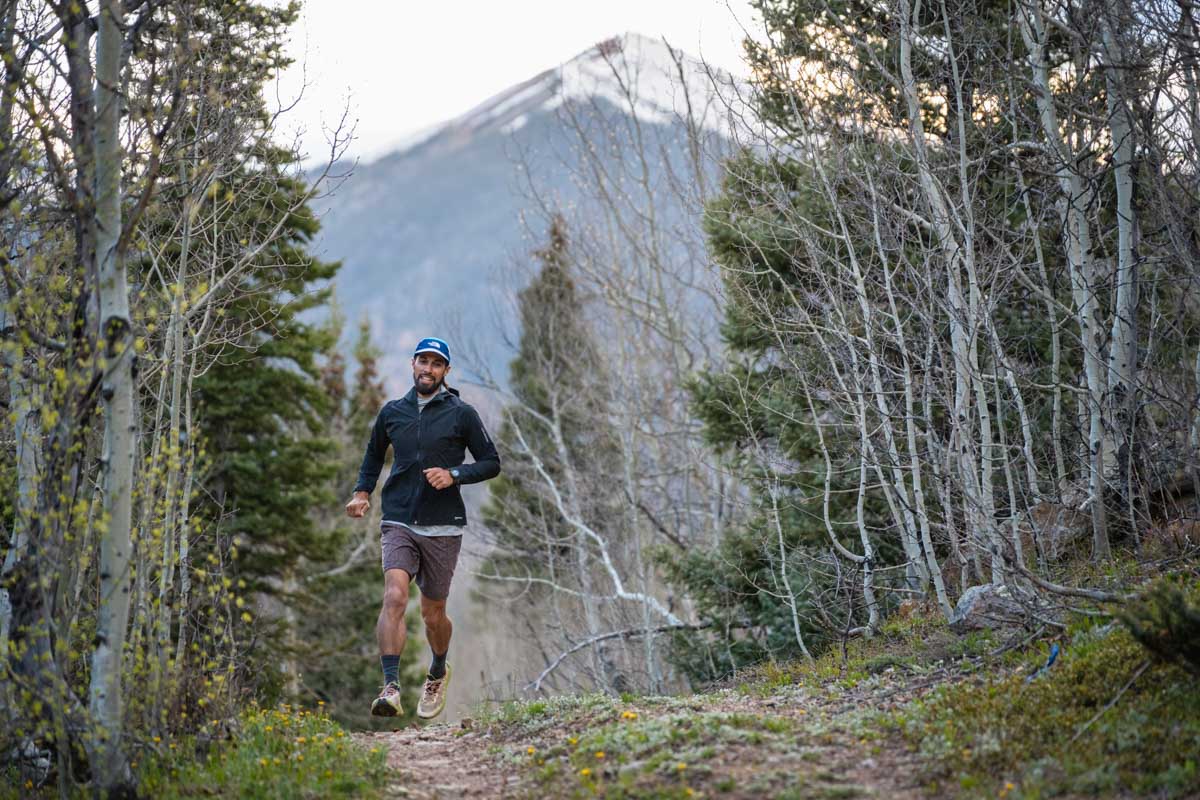
Rain jackets need to be able to breathe to let off moisture during high-level efforts. Photo: iRunFar/Eszter Horanyi
Frequently Asked Questions About Running Rain Jackets
Do I need a running rain jacket?
The answer to this question depends on something fairly simple — how often and long you plan to run in the rain. Some people prefer to hit the treadmill or wait until a storm passes to run outside. Others head to the trail no matter the weather. Still others are out for multi-hour adventures when the weather can switch in a beat.
If you live in an area that gets a lot of rain and you plan to run outside regardless of weather, investing in a high-quality rain jacket like the Patagonia Storm Racer Jacket is probably a worthy choice. While a moderate run in the rain without a jacket isn’t going to hurt you, you’ll likely be a lot more comfortable and perform better with one. In the cold, the best running rain jackets can also keep you dry and warm and protect against more serious conditions like hypothermia. That’s why many races will require runners to carry a rain jacket on the course, regardless of the forecast.
Do I need a fully waterproof rain jacket for running, or will a water-resistant one be good enough?
The answer to this will again largely depend on the climate in which you typically run. A warm-weather runner who might encounter an occasional shower can certainly get by with a lightweight, water-resistant jacket for those just-in-case moments. While we don’t recommend trying to replace a rain jacket with a wind jacket, in some instances, lighter jackets with a DWR coating can get the job done. You can check out options in our Best Windbreaker Jackets guide.
For trail runners heading into the mountains or are out for hours in constant rain and chilly temperatures, we recommend a fully waterproof jacket like the Montbell Rain Trekker Jacket for comfort and safety. The combination of cold air temperatures and wet skin creates a high-risk scenario for hypothermia, which can quickly become life-threatening. Having the proper layers to protect against these elements means you can comfortably enjoy your adventure — and make it home to talk about it.
In addition, many races, particularly those in mountainous terrain or in cold, wet climates, have mandatory kit lists that require participants to carry a waterproof jacket for the duration of the event.
Many runners who frequent the mountains will always carry a rain jacket in case of an unexpected rainstorm and end up using it as a windbreaker more often than as protection against precipitation. A lightweight jacket like the Rab Phantom Waterproof Jacket doesn’t weigh much more than a standard windbreaker.
How are waterproof ratings measured on rain jackets?
While performance in real-life conditions best determines a jacket’s waterproofness, laboratory testing helps establish a baseline rating for the materials used in the construction of waterproof clothing.
The most used measurement of waterproofness is the hydrostatic head, which determines the amount of water a material can withstand before it starts to saturate and leak through. In this test, the fabric is secured over a one-inch diameter tube underneath a column of water of a certain height, and the material is observed for 24 hours. The height of the water column at which the water starts to saturate the fabric and leak is the hydrostatic head, measured in millimeters. A hydrostatic head measurement of 10,000 millimeters is considered the baseline for waterproof jackets.
Please note that while many manufacturers will list hydrostatic head numbers in the specifications for their jackets, not all materials use this rating. Gore-Tex, the company that produces the Windstopper material in the Montbell Rain Trekker Jacket, employs its own rain room to test its garments using specially designed rain nozzles and wind simulators to better approximate actual weather conditions.

iRunFar’s Meghan Hicks wearing the Montbell Rain Trekker Jacket for warmth during a fastpacking trip in Utah. Photo: iRunFar/Eszter Horanyi
How is breathability measured in a rain jacket?
Two types of laboratory-bestowed ratings quantify breathability. The first and most common is the Moisture Vapor Transmission Rate (MVTR). MVTR measures the rate at which water vapor (your sweat) permeates through the fabric. The higher the MVTR rating, the better. Good values of MVTR start around 10,000.
The second is Resistance to Evaporative Heat Loss (RET), which measures the material’s resistance to water vapor. The lower the RET, the better the breathability.
In theory, these numbers correlate to the jacket’s breathability. In practice, many other factors impact a jacket’s comfort and function, and we prefer comparing performance in real-life conditions to making a purchase based on a lab value. The Patagonia Storm Racer Jacket’s good breathability was one factor that led us to name it our best rain jacket for running.
How long will a rain jacket’s waterproofing last?
Sadly, nothing lasts forever, but with proper care and maintenance, you should enjoy many dry and comfortable years with your waterproof jacket. Several factors will impact your waterproof jacket’s lifespan. Repeated exposure to rain, sweat, or body oils will start to wear away at the material’s waterproof coating and membrane over time. Jackets with 2.5-layer construction, like the Outdoor Research Helium Rain Ultralight Jacket, have an inner layer to protect the rest of the jacket from sweat and body oils and can extend the life expectancy of a jacket.

The North Face Summit Series Superior Futurelight Jacket was one of our testing team’s favorite running rain jackets. Photo: iRunFar/Eszter Horanyi
To prevent material degradation, all jackets will come with specific care recommendations, most often avoiding standard detergents when washing and high heat exposure in a dryer. That doesn’t mean you should never wash your jacket. Occasional washing with a laundry soap specifically formulated for waterproof materials will remove dirt and body oils that wear out waterproof fabrics, extending the life of your jacket.
An easy way to extend the life of a waterproof jacket is to refresh the DWR coating. To see if this needs to be done, apply a few drops of water to the exterior of your DWR-coated jacket. If the water soaks in instead of beading up and rolling off, your jacket has lost its water-resistant outer coating.
You can reapply a DWR coating using a spray-on or wash-in product, such as Nikwax, that will bond to the outer material and refresh the jacket’s water-shedding capabilities. Always check your jacket’s care instructions and the instructions on the DWR-replenishment product before applying to be sure it is safe to use.
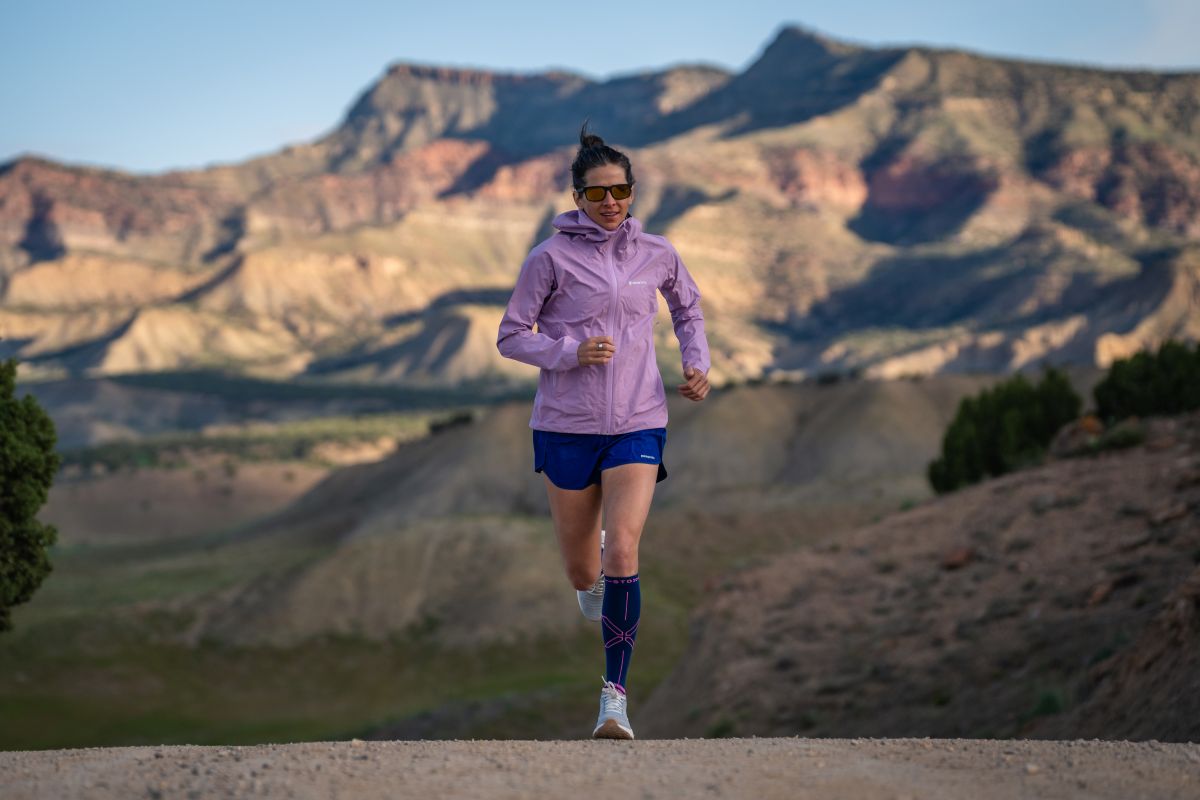
In addition to keeping you dry, the best running rain jacket can help you stay warm on chilly mornings. Photo: iRunFar/Eszter Horanyi
Is there a big difference between men’s and women’s rain jackets for running?
Just as other pieces of apparel do, jackets feature designs to accommodate men’s and women’s unique body shapes. Wide versus narrow shoulders, a straight cut versus a waist taper, and wider and narrower hips are only a few differences between jackets made for different body types. Of course, we always recommend wearing the best jacket that fits your body, regardless of who it was intended for! The Rab Phantom Waterproof Jacket is slimmer than many other jackets we tested, while the Outdoor Research Helium Rain Ultralight Jacket has a much looser overall fit.
Most brands make equivalent models in both men’s and women’s jackets.
Do I need to size up when buying a rain jacket?
While the overall sizing of most rain jackets is fairly standard, they all have various cuts and fit an array of body types differently. If you generally only toss a rain jacket on over a single layer, or maybe a thin insulating layer, you can probably get away with the same-sized rain jacket as the rest of your running wardrobe. It’s probably worth sizing up if you’re running in environments where you have to layer up underneath a rain jacket. If you want to be able to wear a small pack under your rain jacket, you’ll probably need to size up as well. The Salomon Bonatti Trail jacket is specially designed to accommodate a pack underneath. While the material in many rain jackets has some stretch to it, some jackets don’t have a lot of give and can inhibit your range of motion if it’s too small. The Outdoor Research Helium Rain Ultralight Jacket has less stretch than many other options in this guide. Choosing the larger size is often worth it if you’re between sizes.
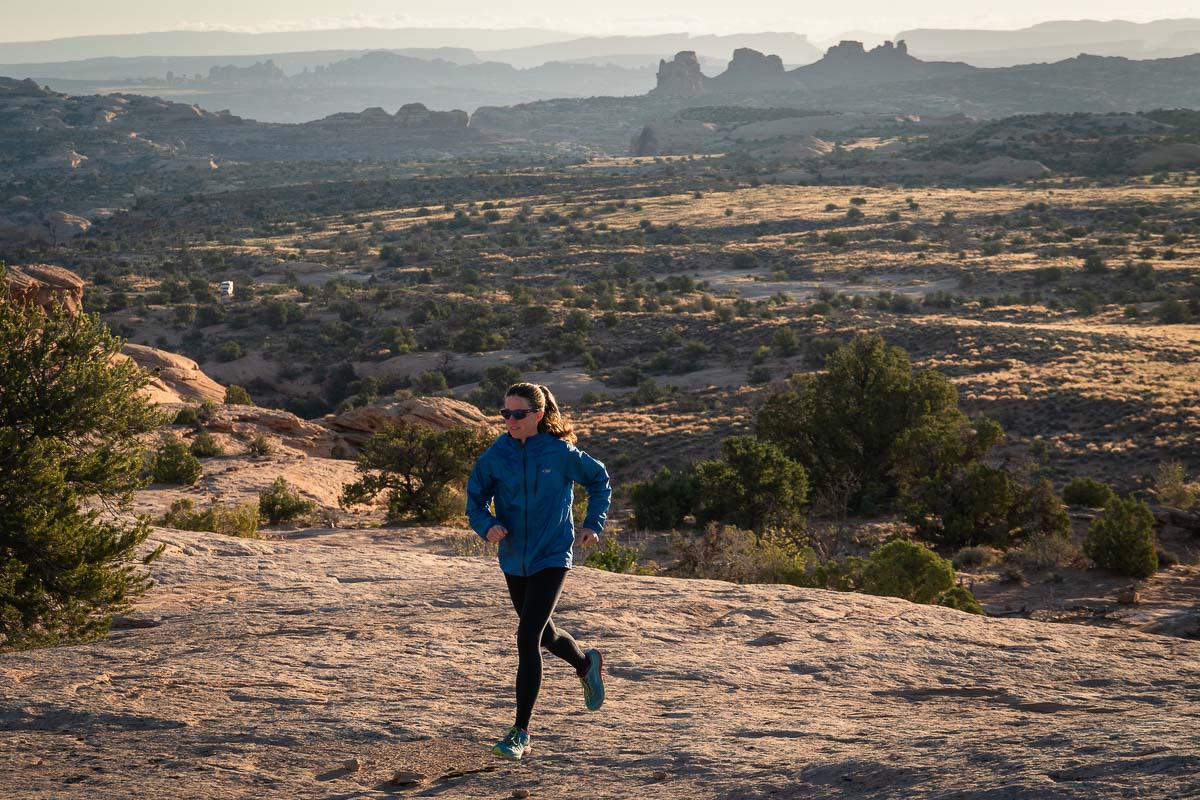
The Outdoor Research Helium Rain Ultralight Jacket can be worn on rainy and sunny adventures. Photo: iRunFar/Eszter Horanyi
Should I prioritize weight or protection in a rain jacket?
This comes down to the conditions you generally run in, and also how much you can spend. Generally, the highest-priced items will offer both minimal weight and maximal protection. But if you’re looking to save a bit of money, you’ll likely have to sacrifice one or the other. If weight is your biggest concern, the Rab Phantom Waterproof Jacket was our top ultralight pick. If you value protection, we loved The North Face Summit Series Superior Futurelight Jacket for its all-day, all-weather protection, even though it’s the heaviest jacket in this guide. In the end, the best running rain jacket is one you’re willing to carry, even if it’s not the most protective one available, so you’ll want to get one you’re not averse to putting in your pack for any run.
Is it worth paying more for an expensive rain jacket?
While you can technically run in a trash bag or an inexpensive $3 poncho and stay relatively dry, buying a high-quality rain jacket like the The North Face Summit Series Superior Futurelight Jacket is probably a smart investment in the long run. The best running rain jacket will protect you from the rain while allowing moisture from sweat to escape from the inside. This breathability is what sets rain jackets apart from trash bags and ponchos.
A breathable and waterproof jacket isn’t cheap — the advanced materials and treatments used to keep rain and moisture out require a lot of research and development, which comes at a premium price — but it can make running in the rain much safer and more comfortable. Well-constructed rain jackets can also last for a long time, so you can consider them an important investment in your running gear. Proper care of a 2.5-layer jacket like the Salomon Bonatti Trail can keep it waterproof for a long time, as can adding a new DWR coating when it loses its outer layer of waterproofness.
Call for Comments
- What is your favorite running rain jacket, and why?
- What features have you found to be the most practical and useful in your waterproof running jacket?
- What conditions or terrain do you most often reach for a waterproof layer?
